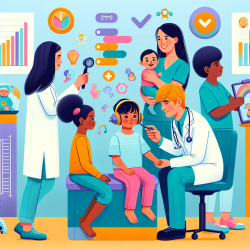Gray Matter Features of Reading Disability: Insights for Practitioners
As a speech-language pathologist dedicated to improving outcomes for children, staying informed about the latest research is crucial. A recent study titled Gray Matter Features of Reading Disability: A Combined Meta-Analytic and Direct Analysis Approach provides valuable insights into the neuroanatomical underpinnings of reading disabilities. This blog post aims to translate these findings into actionable strategies for practitioners.
Understanding the Research
The study conducted a meta-analysis of voxel-based morphometry (VBM) studies and a direct analysis of 293 cases to identify consistent gray matter features associated with reading disabilities. The findings revealed that individuals with reading disabilities exhibit lower gray matter volume in the left posterior superior temporal sulcus/middle temporal gyrus and left orbitofrontal gyrus/pars orbitalis regions. These regions are crucial for reading comprehension and phonological processing.
Key Findings
- Consistent Gray Matter Differences: Lower gray matter volume in the left posterior superior temporal sulcus/middle temporal gyrus and left orbitofrontal gyrus/pars orbitalis regions.
- Predictive Value: Gray matter volume in these regions significantly predicted individual variation in reading comprehension.
- Genetic Links: These gray matter differences are associated with genetic markers that confer risk for reading disabilities.
Implications for Practitioners
Understanding these neuroanatomical differences can help practitioners tailor their interventions more effectively. Here are some strategies based on the study's findings:
1. Focus on Phonological Processing
The left posterior superior temporal sulcus/middle temporal gyrus is involved in phonological processing. Interventions that target phonological awareness, such as phonemic segmentation and blending exercises, can be particularly beneficial for children with reading disabilities.
2. Enhance Reading Comprehension
Given the role of the left orbitofrontal gyrus/pars orbitalis in reading comprehension, strategies that improve comprehension skills should be prioritized. Techniques such as story mapping, summarization, and questioning can help strengthen these skills.
3. Utilize Data-Driven Approaches
The study underscores the importance of using data to guide interventions. Regularly assess and monitor gray matter volume and reading skills to tailor interventions to each child's specific needs. Tools like functional MRI (fMRI) and other neuroimaging techniques can provide valuable insights.
4. Consider Genetic Factors
Understanding the genetic basis of reading disabilities can inform intervention strategies. Genetic testing and counseling may be beneficial for families to understand the hereditary nature of these disabilities and to develop personalized intervention plans.
Encouraging Further Research
While this study provides significant insights, it also highlights the need for further research. Practitioners are encouraged to stay abreast of ongoing studies and contribute to research efforts. Collaborative research can help refine our understanding of the neuroanatomical and genetic factors underlying reading disabilities.
Conclusion
The findings from the study Gray Matter Features of Reading Disability: A Combined Meta-Analytic and Direct Analysis Approach offer valuable insights for practitioners. By focusing on phonological processing, enhancing reading comprehension, utilizing data-driven approaches, and considering genetic factors, practitioners can improve outcomes for children with reading disabilities.
To read the original research paper, please follow this link: Gray Matter Features of Reading Disability: A Combined Meta-Analytic and Direct Analysis Approach.










